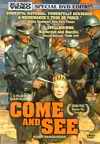Come And See
Kino Film
Cast:
Extras: Interviews, Featurettes, Photo Stills, Cast & Crew Filmographies
Rating:
The Russian Cinema Council (Ruscico) is dedicated to restoring and distributing the best of Soviet and Russian cinema. While the technical merits of their DVD releases are often lacking, the effort put into the special features and overall care shown for the material typically make these DVDs a real treat for foreign film fans.
The latest DVD to come from Ruscico (distributed in this case by Kino Video) is Elem Klimov’s 1985 award-winning and final film ’Come and See’ (Idi i smotri). Focusing on the partisan struggle against the Nazis in the Soviet republic of Byelorussia during World War Two, ’Come and See’ stands as one of the bleakest war movies ever made in any language.
The time is 1943 and Florya (Aleksei Kravchenko), a teenage boy, joins the local partisans in his native Belarus to fight against the Nazi invaders. Expecting to experience the romance of battle, Florya is soon awakened to the harsh reality of modern war as he returns home from a skirmish only to find his entire family slaughtered. Having joined up with the beautiful peasant girl Glasha, the two wander through a landscape that is the epitome of hell on earth.
’Come and See’ is presented on DVD in its original full frame aspect ratio of 1.33:1 and is split between two DVDs. The picture is plagued by compression artifacts, severe halo effects, and digital noise and it appears that low quality analog sources were used to master these DVDs. In addition, colors tend to smear and black levels are unstable. Not surprisingly, the transfer is also grainy and exhibits its fair share of blemishes. The DVD is by no means unwatchable but it’s unfortunate that Ruscico isn’t better equipped to create DVD transfers.
Audio is presented in the original Russian as well as dubbed English and Arabic Dolby Digital 5.1 mixes. While the audio fares better than the video, it still comes off sounding gimmicky with dialogue issuing from all speakers and juiced up surround effects punctuating what is usually a very low key audio mix. Some rumbling bass is evident here and there but rarely in the scenes where one might expect it. Also, audio and subtitle options must be selected from the main menu before starting the feature as on-the-fly switching is disabled.
’Come and See’ is an important example of Soviet-era cinema and the DVD contains some insightful bonus features. First up are three new interviews. First is a 21-minute preface to the film drawn from an interview with director Elem Klimov. This is followed by a 13-minute piece with star Aleksei Kravchenko and an 8-minute interview with production designer Victor Petrov.
Also included are two new featurettes created from documentary footage shot in Byelorussia during the war. The 11-minute ’Partisans in Belarus’ and the 5-minute ’Nazis’ Brutalities’ offer an exceedingly grim look at the harsh reality of life and death on the Eastern Front.
Rounding out the extras are a series of production photographs and cast and crew filmographies.
’Come and See’ is at once a riveting and repulsive cinematic experience. Elem Klimov’s deft direction draws viewers in with haunting, beautiful imagery only to blindside them with some of the most brutal depictions of the aftermath of war ever depicted on film. Very little actual conflict is witnessed but this just serves to make the film that much more jarring to the senses. This is not a typical war movie by any means and is instead a drama that explores the triumph of the human spirit in even the darkest of days.
Ruscico’s new DVD release receives very low marks for technical merit but wins some points for offering this important classic with a handful of informative bonus features. I really can’t recommend a purchase for any but the most hardcore fans of Soviet-era cinema but I’m personally glad to have this disc in my collection and am willing to overlook its many shortcomings for the sake of the film itself.
One more word of caution. Kino Video has chosen to brand these Ruscico discs by placing small silver ’Kino Video’ stickers on the surface of each DVD. The thought of having an adhesive-backed item spinning around inside a DVD player is a bit unsettling.

